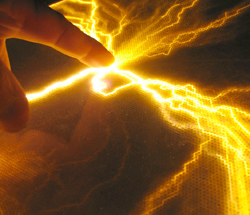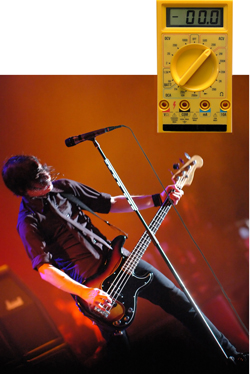
Testing, Testing
So let’s say you’ve managed to make your system hum-free while maintaining your solid console and backline grounds.
Now the overwhelming goal should be proving, beyond doubt, that the system is absolutely safe. Four steps of progressively increasing intensity should be taken to insure this:
1) Meter the mic to the instrument strings. Touch bare metal on the mic – some mics have painted grills, so the meter will read “0 volts,” but there are often small spots where the paint has chipped away that can zap a singer.
Wireless guitars will always measure safe, but if there’s a hardwired spare guitar, it must be checked with the meter.
Even if a singer doesn’t play an instrument, keep in mind that barefoot singers and/or wet stages can be a problem if the stage is metal or if there are screws in the stage that attach to its metal frame.
Therefore, meter any metal that the performer may come in contact with. You’re looking for less than 1 volt or so, and be sure to check for both AC and DC voltages.
2) Turn on the guitar rig, and with the guitar plugged in, touch the guitar strings to a bare metal part of the mic. The XLR connector often provides a good bare metal connection.

If the guitar rig produces an audible buzz when the strings touch the mic then there is a potential hazard.
And if the strings melt and a blue spark erupts, it’s a sure sign of things being not so good. If this happens, do not proceed to step 3 without resolving the problem.
3) Now comes the “fun” stuff. If you’re willing to let a performer touch the mic and hold a guitar, then you should be willing to do it yourself (or at least the potential of a lawsuit may inspire you a bit).
Hold the strings of the instrument and touch the mic gently with your finger, and work your way up to a your way up to a solid grab of the mic.
If you measure 0 volts and get no buzz from touching the strings, then the mic is quite likely going to be shock-free.
The main purpose of this step is to prepare you for the next one.
4) The last and final proof is to do as the performers will do themselves: put your lips to the mic while holding the plugged-in instrument.
Feeling Electricity
I’ve been called on many times over the years to resolve shock problems in a wide variety of situations.
Once, at a well-known Hollywood nightclub, a performer refused to play, swearing she was getting shocked by her vocal mic – but the AC meter consistently read 0 volts.
It turns out that it was the 48-volt phantom power going to her acoustic (and active) direct box, combined with a poorly grounded snake. AC metering showed no potential, because the voltage was DC.
I replaced the active direct boxes with passive ones, and then while she watched, licked the mic while holding her guitar. This reassurance was convincing enough to save the show, although she wanted a different mic!
I can already feel the backlash of those who will shout unsafe practices and not testing electricity with your own body. I agree wholeheartedly.
However, my point is that if you don’t trust that a setup is safe – so safe that you will subject yourself to the same situation you put performers in – then get someone qualified that knows what they’re doing and is willing to stand behind their work.
The consequences are far too serious, folks.
Dave Rat is the co-founder and owner of Rat Sound, a leading sound reinforcement company based in California.
